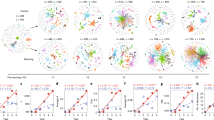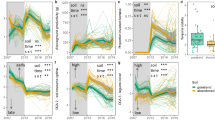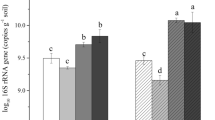Abstract
Soils harbor highly diverse microbial communities that are critical to soil health, but agriculture has caused extensive land use conversion resulting in negative effects on critical ecosystem processes. However, the responses and adaptations of microbial communities to land use conversion have not yet been understood. Here, we examined the effects of land conversion for long-term crop use on the network complexity and stability of soil microbial communities over 19 months. Despite reduced microbial biodiversity in comparison with native tallgrass prairie, conventionally tilled (CT) cropland significantly increased network complexity such as connectivity, connectance, average clustering coefficient, relative modularity, and the number of species acting at network hubs and connectors as well as resulted in greater temporal variation of complexity indices. Molecular ecological networks under CT cropland became significantly more robust and less vulnerable, overall increasing network stability. The relationship between network complexity and stability was also substantially strengthened due to land use conversion. Lastly, CT cropland decreased the number of relationships between network structure and environmental properties instead being strongly correlated to management disturbances. These results indicate that agricultural disturbance generally increases the complexity and stability of species “interactions”, possibly as a trade-off for biodiversity loss to support ecosystem function when faced with frequent agricultural disturbance.
This is a preview of subscription content, access via your institution
Access options
Subscribe to this journal
We are sorry, but there is no personal subscription option available for your country.
Buy this article
- Purchase on Springer Link
- Instant access to full article PDF
Prices may be subject to local taxes which are calculated during checkout




Similar content being viewed by others
Code availability
16S rRNA gene sequences were deposited to the Sequence Read Archive (SRA) under the project accession number PRJNA954023. The R scripts and Python 3 scripts were adapted from the publicly available code on GitHub at https://github.com/Mengting-Maggie-Yuan/warming-network-complexity-stability with the identifier https://doi.org/10.5281/zenodo.4383469.
References
Verchot LV. Impacts of forest conversion to agriculture on microbial communities and microbial function. In: Dion P, ed. Soil Biology and Agriculture in the Tropics. Berlin, Heidelberg: Springer Berlin Heidelberg; 2010. p. 45–63.
Shaoqiang W, Jiyuan L, Guirui Y, Yuanyuan P, Qingmei C, Kerang L, et al. Effects of land use change On the storage of soil organic carbon: A case study of the Qianyanzhou forest experimental station in China. Clim Change. 2004;67:247–55.
Lark TJ, Larson B, Schelly I, Batish S, Gibbs HK. Accelerated conversion of native prairie to cropland in Minnesota. Environ Conserv. 2019;46:155–62.
Hoekstra JM, Boucher TM, Ricketts TH, Roberts C. Confronting a biome crisis: global disparities of habitat loss and protection. Ecol Lett. 2005;8:23–9.
Lark TJ, Salmon JM, Gibbs HK. Cropland expansion outpaces agricultural and biofuel policies in the United States. Environ Res Lett. 2015;10:044003.
Bajgain R, Xiao X, Basara J, Wagle P, Zhou Y, Mahan H, et al. Carbon dioxide and water vapor fluxes in winter wheat and tallgrass prairie in central Oklahoma. Sci Total Environ. 2018;644:1511–24.
Doran JW, Zeiss MR. Soil health and sustainability: managing the biotic component of soil quality. Appl Soil Ecol. 2000;15:3–11.
Trivedi P, Delgado-Baquerizo M, Anderson IC, Singh BK. Response of soil properties and microbial communities to agriculture: Implications for primary productivity and soil health indicators. Front Plant Sci. 2016;7:990.
Lauber CL, Strickland MS, Bradford MA, Fierer N. The influence of soil properties on the structure of bacterial and fungal communities across land-use types. Soil Biol Biochem. 2008;40:2407–15.
Ding GC, Piceno YM, Heuer H, Weinert N, Dohrmann AB, Carrillo A, et al. Changes of soil bacterial diversity as a consequence of agricultural land use in a semi-arid ecosystem. PLoS ONE. 2013;8:e59497.
Ishaq SL, Seipel T, Yeoman CJ, Menalled FD. Soil bacterial communities of wheat vary across the growing season and among dryland farming systems. Geoderma. 2020;358:113989.
Bainard L, Hamel C, Gan Y. Edaphic properties override the influence of crops on the composition of the soil bacterial community in a semiarid agroecosystem. Appl Soil Ecol. 2016;105:160–8.
Fierer N. Embracing the unknown: disentangling the complexities of the soil microbiome. Nat Rev Microbiol. 2017;15:579–90.
Lacerda-Júnior GV, Noronha MF, Cabral L, Delforno TP, de Sousa STP, Fernandes-Júnior PI, et al. Land use and seasonal effects on the soil microbiome of a Brazilian dry forest. Front Microbiol. 2019;10:648.
Liu XB, Zhang XY, Wang YX, Sui YY, Zhang S, Herbert S, et al. Soil degradation: A problem threatening the sustainable development of agriculture in Northeast China. Plant Soil Environ. 2010;56:87–97.
Six J, Elliott ET, Paustian K. Aggregate and soil organic matter dynamics under conventional and no-tillage systems. Soil Sci Soc Am J. 1999;63:1350–8.
Deng Y, Jiang YH, Yang Y, He Z, Luo F, Zhou J. Molecular ecological network analyses. BMC Bioinform. 2012;13:113.
Zhou J, Deng Y, Luo F, He Z, Tu Q, Zhi X. Functional molecular ecological networks. mBio. 2010;1:e00169–10.
Barberan A, Bates ST, Casamayor EO, Fierer N. Using network analysis to explore co-occurrence patterns in soil microbial communities. ISME J. 2012;6:343–51.
Zhou J, Deng Y, Luo F, He Z, Yang Y. Phylogenetic molecular ecological network of soil microbial communities in response to elevated CO2. mBio. 2011;2:e00122–11.
Faust K, Raes J. Microbial interactions: from networks to models. Nat Rev Microbiol. 2012;10:538–50.
Yuan MM, Guo X, Wu L, Zhang Y, Xiao N, Ning D, et al. Climate warming enhances microbial network complexity and stability. Nat Clim Change. 2021;11:343–8.
Montoya JM, Pimm SL, Solé RV. Ecological networks and their fragility. Nature. 2006;442:259–64.
Deng Y, Zhang P, Qin Y, Tu Q, Yang Y, He Z, et al. Network succession reveals the importance of competition in response to emulsified vegetable oil amendment for uranium bioremediation. Environ Microbiol. 2016;18:205–18.
Wu L, Yang Y, Chen S, Zhao M, Zhu Z, Yang S, et al. Long-term successional dynamics of microbial association networks in anaerobic digestion processes. Water Res. 2016;104:1–10.
Tian J, He N, Kong W, Deng Y, Feng K, Green SM, et al. Deforestation decreases spatial turnover and alters the network interactions in soil bacterial communities. Soil Biol Biochem. 2018;123:80–6.
Jia M, Gao Z, Gu H, Zhao C, Liu M, Liu F, et al. Effects of precipitation change and nitrogen addition on the composition, diversity, and molecular ecological network of soil bacterial communities in a desert steppe. PLoS ONE. 2021;16:e0248194.
Li B-B, Roley SS, Duncan DS, Guo J, Quensen JF, Yu H-Q, et al. Long-term excess nitrogen fertilizer increases sensitivity of soil microbial community to seasonal change revealed by ecological network and metagenome analyses. Soil Biol Biochem. 2021;160:108349.
Yan Y, Kuramae EE, de Hollander M, Klinkhamer PG, van Veen JA. Functional traits dominate the diversity-related selection of bacterial communities in the rhizosphere. ISME J. 2017;11:56–66.
Pocock MJO, Evans DM, Memmott J. The robustness and restoration of a network of ecological networks. Science. 2012;335:973–7.
Cornell CR, Zhang Y, Nostrand JDV, Wagle P, Xiao X, Zhou J. Temporal changes of virus-like particle abundance and metagenomic comparison of viral communities in cropland and prairie soils. mSphere. 2021;6:e01160–20.
Cornell CR, Zhang Y, Ning D, Wu L, Wagle P, Steiner Jean L, et al. Temporal dynamics of bacterial communities along a gradient of disturbance in a U.S. southern plains agroecosystem. mBio. 2022;13:e03829–21.
Kitano H. Biological robustness. Nat Rev Genet. 2004;5:826–37.
Galiana N, Lurgi M, Claramunt-Lopez B, Fortin MJ, Leroux S, Cazelles K, et al. The spatial scaling of species interaction networks. Nat Ecol Evol. 2018;2:782–90.
Barberán A, Bates ST, Casamayor EO, Fierer N. Using network analysis to explore co-occurrence patterns in soil microbial communities. ISME J. 2012;6:343–51.
Zhou J, Ning D. Stochastic community assembly: Does it matter in microbial ecology? Microbiol Mol Biol Rev. 2017;81:e00002–17.
Blanchet FG, Cazelles K, Gravel D. Co-occurrence is not evidence of ecological interactions. Ecol Lett. 2020;23:1050–63.
Montecchia MS, Tosi M, Soria MA, Vogrig JA, Sydorenko O, Correa OS. Pyrosequencing reveals changes in soil bacterial communities after conversion of Yungas forests to agriculture. PLoS ONE. 2015;10:e0119426.
Lauber CL, Ramirez KS, Aanderud Z, Lennon J, Fierer N. Temporal variability in soil microbial communities across land-use types. ISME J. 2013;7:1641–50.
Banerjee S, Schlaeppi K, van der Heijden MGA. Reply to ‘Can we predict microbial keystones?’. Nat Rev Microbiol. 2019;17:194.
Tu Q, Yan Q, Deng Y, Michaletz ST, Buzzard V, Weiser MD, et al. Biogeographic patterns of microbial co-occurrence ecological networks in six American forests. Soil Biol Biochem. 2020;148:107897.
Philippot L, Raaijmakers JM, Lemanceau P, van der Putten WH. Going back to the roots: the microbial ecology of the rhizosphere. Nat Rev Microbiol. 2013;11:789–99.
Tu Q, Zhou X, He Z, Xue K, Wu L, Reich P, et al. The diversity and co-occurrence patterns of N2-fixing communities in a CO2-enriched grassland ecosystem. Micro Ecol. 2016;71:604–15.
Zhang B, Zhang J, Liu Y, Shi P, Wei G. Co-occurrence patterns of soybean rhizosphere microbiome at a continental scale. Soil Biol Biochem. 2018;118:178–86.
Shi S, Nuccio EE, Shi ZJ, He Z, Zhou J, Firestone MK. The interconnected rhizosphere: High network complexity dominates rhizosphere assemblages. Ecol Lett. 2016;19:926–36.
Montesinos-Navarro A, Hiraldo F, Tella JL, Blanco G. Network structure embracing mutualism–antagonism continuums increases community robustness. Nat Ecol Evol. 2017;1:1661–9.
Banerjee S, Schlaeppi K, van der Heijden MGA. Keystone taxa as drivers of microbiome structure and functioning. Nat Rev Microbiol. 2018;16:567–76.
Zelikova TJ, Blumenthal DM, Williams DG, Souza L, LeCain DR, Morgan J, et al. Long-term exposure to elevated CO2 enhances plant community stability by suppressing dominant plant species in a mixed-grass prairie. Proc Natl Acad Sci USA. 2014;111:15456–61.
McKinney ML, Lockwood JL. Biotic homogenization: a few winners replacing many losers in the next mass extinction. Trends Ecol Evol. 1999;14:450–3.
Smart SM, Thompson K, Marrs RH, Le Duc MG, Maskell LC, Firbank LG. Biotic homogenization and changes in species diversity across human-modified ecosystems. Proc R Soc B: Biol Sci. 2006;273:2659–65.
Rodrigues JLM, Pellizari VH, Mueller R, Baek K, Jesus EDC, Paula FS, et al. Conversion of the Amazon rainforest to agriculture results in biotic homogenization of soil bacterial communities. Proc Natl Acad Sci USA. 2013;110:988.
Olden JD, Poff NL. Toward a mechanistic understanding and prediction of biotic homogenization. Am Nat. 2003;162:442–60.
Olden JD, LeRoy Poff N, Douglas MR, Douglas ME, Fausch KD. Ecological and evolutionary consequences of biotic homogenization. Trends Ecol Evol. 2004;19:18–24.
MacArthur R. Fluctuations of animal populations and a measure of community stability. Ecology. 1955;36:533–6.
May RM. Stability and complexity in model ecosystems. Princeton NJ, USA: Princeton University Press; 2001.
Okuyama T, Holland JN. Network structural properties mediate the stability of mutualistic communities. Ecol Lett. 2008;11:208–16.
Landi P, Minoarivelo HO, Brännström Å, Hui C, Dieckmann U. Complexity and stability of ecological networks: a review of the theory. Popul Ecol. 2018;60:319–45.
Pimm SL. The complexity and stability of ecosystems. Nature. 1984;307:321–6.
Helbing D. Globally networked risks and how to respond. Nature. 2013;497:51–9.
Fierer N, Jackson RB. The diversity and biogeography of soil bacterial communities. Proc Natl Acad Sci USA. 2006;103:626–31.
Yao M, Rui J, Niu H, Heděnec P, Li J, He Z, et al. The differentiation of soil bacterial communities along a precipitation and temperature gradient in the eastern Inner Mongolia steppe. Catena. 2017;152:47–56.
Thomson BC, Tisserant E, Plassart P, Uroz S, Griffiths RI, Hannula SE, et al. Soil conditions and land use intensification effects on soil microbial communities across a range of European field sites. Soil Biol Biochem. 2015;88:403–13.
Guo X, Chen HYH, Meng M, Biswas SR, Ye L, Zhang J. Effects of land use change on the composition of soil microbial communities in a managed subtropical forest. Ecol Manag. 2016;373:93–9.
Vitousek PM, Howarth RW. Nitrogen limitation on land and in the sea: How can it occur? Biogeochemistry. 1991;13:87–115.
Lauenroth W, Burke I, Paruelo J. Patterns of production and precipitation-use efficiency of winter wheat and native grasslands in the central great plains of the United States. Ecosystems. 2000;3:344–51.
Chase JM. Drought mediates the importance of stochastic community assembly. Proc Natl Acad Sci USA. 2007;104:17430.
Huang M, Chai L, Jiang D, Zhang M, Jia W, Huang Y, et al. Dissolved organic matter (DOM) quality drives biogeographic patterns of soil bacterial communities and their association networks in semi-arid regions. FEMS Microbiol Ecol. 2021;97:fiab083.
Lu L, Yin S, Liu X, Zhang W, Gu T, Shen Q, et al. Fungal networks in yield-invigorating and -debilitating soils induced by prolonged potato monoculture. Soil Biol Biochem. 2013;65:186–94.
Mougi A, Kondoh M. Diversity of interaction types and ecological community stability. Science. 2012;337:349–51.
Kleinman PJA, Spiegal S, Rigby JR, Goslee SC, Baker JM, Bestelmeyer BT, et al. Advancing the sustainability of US agriculture through long-term research. J Environ Qual. 2018;47:1412–25.
Spiegal S, Bestelmeyer B, Archer D, Augustine D, Boughton E, Boughton R, et al. Evaluating strategies for sustainable intensification of US agriculture through the Long-Term Agroecosystem Research network. Environ Res Lett. 2018;13:034031.
Bajgain R, Xiao X, Basara J, Doughty R, Wu X, Wagle P, et al. Differential responses of native and managed prairie pastures to environmental variability and management practices. Agric Meteorol. 2020;294:108137.
Peterson BL, Hanna L, Steiner JL. Reduced soil disturbance: Positive effects on greenhouse gas efflux and soil N losses in winter wheat systems of the southern plains. Soil Tillage Res. 2019;191:317–26.
Hendershot W, Lalande H, Duquette M. Soil reaction and exchangeable acidity. In: Carter MR, Gregorich EG, eds. Soil sampling and methods of analysis. 2nd ed. Boca Raton, FL, USA: CRC Press; 2007. p. 173–8.
Zhou J, Bruns MA, Tiedje JM. DNA recovery from soils of diverse composition. Appl Environ Microbiol. 1996;62:316–22.
Ding J, Zhang Y, Deng Y, Cong J, Lu H, Sun X, et al. Integrated metagenomics and network analysis of soil microbial community of the forest timberline. Sci Rep. 2015;5:7994.
Edgar RC. Search and clustering orders of magnitude faster than BLAST. Bioinformatics. 2010;26:2460–1.
Edgar RC. UNOISE2: improved error-correction for Illumina 16S and ITS amplicon sequencing. bioRxiv. 2016:081257.
Prodan A, Tremaroli V, Brolin H, Zwinderman AH, Nieuwdorp M, Levin E. Comparing bioinformatic pipelines for microbial 16S rRNA amplicon sequencing. PLoS ONE. 2020;15:e0227434.
Carr A, Diener C, Baliga NS, Gibbons SM. Use and abuse of correlation analyses in microbial ecology. ISME J. 2019;13:2647–55.
Aitchison J. Principles of Compositional Data Analysis. Lecture Notes-Monograph Series. 24: Institute of Mathematical Statistics; 1994.24:73–81.
Sabri H, Hashemi SS, Maleki BR, Jafarizadeh MA. Generalization of Brody distribution for statistical investigation. Random Matricies: Theory Appl. 2014;03:1450017.
Xiao N, Zhou A, Kempher M, Zhou B, Shi Z, Yuan M, et al. Disentangling direct from indirect relationships in association networks. Proc Natl Acad Sci USA. 2022;119:e2109995119.
Lima-Mendez G, Faust K, Henry N, Decelle J, Colin S, Carcillo F, et al. Ocean plankton. Determinants of community structure in the global plankton interactome. Science. 2015;348:1262073.
Zhou J, He Z, Yang Y, Deng Y, Tringe SG, Alvarez-Cohen L. High-throughput metagenomic technologies for complex microbial community analysis: open and closed formats. mBio. 2015;6:e02288–14.
Maslov S, Sneppen K. Specificity and stability in topology of protein networks. Science. 2002;296:910–3.
Shannon P, Markiel A, Ozier O, Baliga NS, Wang JT, Ramage D, et al. Cytoscape: a software environment for integrated models of biomolecular interaction networks. Genome Res. 2003;13:2498–504.
Thebault E, Fontaine C. Stability of ecological communities and the architecture of mutualistic and trophic networks. Science. 2010;329:853–6.
Guimera R, Nunes Amaral LA. Functional cartography of complex metabolic networks. Nature. 2005;433:895–900.
Olesen JM, Bascompte J, Dupont YL, Jordano P. The modularity of pollination networks. Proc Natl Acad Sci USA. 2007;104:19891.
Rottjers L, Faust K. Can we predict keystones? Nat Rev Microbiol. 2019;17:193.
R Core Team. R: A language and environment for statistical computing. Vienna, Austria: R Foundation for Statistical Computing; 2020.
Oksanen J, Blanchet FG, Kindt R, Legendre P, Minchin P, O’Hara RB, et al. Vegan: Community ecology package. R Package Version. 2019;2:5–6.
Dunne JA, Williams RJ, Martinez ND. Food-web structure and network theory: The role of connectance and size. Proc Natl Acad Sci USA. 2002;99:12917–22.
Hautier Y, Seabloom EW, Borer ET, Adler PB, Harpole WS, Hillebrand H, et al. Eutrophication weakens stabilizing effects of diversity in natural grasslands. Nature. 2014;508:521–5.
Hui C, McGeoch MA, Susan H, Judith LB. Zeta diversity as a concept and metric that unifies incidence-based biodiversity patterns. Am Nat. 2014;184:684–94.
Rosseel Y. lavaan: an R package for structural equation modeling. J Stat Softw. 2012;48:1–36.
Acknowledgements
This study was funded by the USDA National Institute of Food and Agriculture (NIFA) award 2016-68002-24967. It was also supported in part by the USDA-ARS Office of National Programs (Project number: 3070-21610-003-00D) and USDA-LTAR (Long-Term Agroecosystem Research) Network. USDA is an equal opportunity provider and employer. Computing for this project was performed at the OU Supercomputing Center for Education & Research (OSCER) at the University of Oklahoma (OU).
Author information
Authors and Affiliations
Contributions
JZ and XX designed research; CRC collected soil samples; PW provided site data; CRC and YZ performed research; CRC, YZ, DN, and NX analyzed data; CRC and YZ wrote paper; DN, NX, PW, JZ, and XX reviewed and edited paper.
Corresponding author
Ethics declarations
Competing interests
The authors declare no competing interest.
Additional information
Publisher’s note Springer Nature remains neutral with regard to jurisdictional claims in published maps and institutional affiliations.
Supplementary information
Rights and permissions
Springer Nature or its licensor (e.g. a society or other partner) holds exclusive rights to this article under a publishing agreement with the author(s) or other rightsholder(s); author self-archiving of the accepted manuscript version of this article is solely governed by the terms of such publishing agreement and applicable law.
About this article
Cite this article
Cornell, C.R., Zhang, Y., Ning, D. et al. Land use conversion increases network complexity and stability of soil microbial communities in a temperate grassland. ISME J 17, 2210–2220 (2023). https://doi.org/10.1038/s41396-023-01521-x
Received:
Revised:
Accepted:
Published:
Issue Date:
DOI: https://doi.org/10.1038/s41396-023-01521-x



